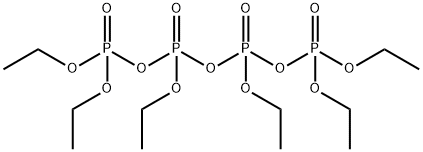Hexaethyl tetraphosphate is a yellow liquid which is miscible with water and many organic solvents except kerosene; hydrolyzes in low concentration; hygroscopic. decomposes at high temperatures. It is difficult to burn. It is toxic by skin absorption and inhalation. It is a mixture of ethyl phosphates and ethyl pyrophosphate. It decomposes at high temperatures. May be found in the form of a dry mixture where the liquid is absorbed onto a dry carrier.
Hexaethyl tetraphosphate is used as an insecticide, in particular, the insecticide Bladan. The Germans commonly used this chemical as an insecticide during World War II, when nicotine-based insecticides were not available.
A mixture of ethyl phosphates and ethyl pyrophosphates (TEPP).
Hexaethyl tetraphosphate was first synthesised by the German chemist Gerhard Schrader, who reacted phosphorus oxychloride and triethyl orthophosphate at approximately 150 °C. This reaction is known as the Schrader process. The Germans also made hexaethyl tetraphosphate by phosphorus oxychloride and ethyl alcohol. This reaction requires slightly lower pressure than the Schrader process.
The reaction has a chemical equation of POCl3 + 3(C2H5)3PO4 → (C2H5)6P4O13 + 3C2H5Cl.
Tetraethyl pyrophosphate solid is a solid material on which the phosphate itself is absorbed. The phosphate itself is combustible though Hexaethyl tetraphosphate may take effort to ignite. Hexaethyl tetraphosphate is soluble in water and gradually decomposed by it. Hexaethyl tetraphosphate is toxic by inhalation(dust, etc) and by skin absorption.
Hexaethyl tetraphosphate is soluble in water and gradually decomposed by it.
Organophosphates are susceptible to formation of highly toxic and flammable phosphine gas in the presence of strong reducing agents such as hydrides. Partial oxidation by oxidizing agents may result in the release of toxic phosphorus oxides.
Toxic by ingestion, inhalation, and skin
absorption; cholinesterase inhibitor.
Highly toxic, may be fatal if inhaled, swallowed or absorbed through skin. Contact with molten substance may cause severe burns to skin and eyes. Avoid any skin contact. Effects of contact or inhalation may be delayed. Fire may produce irritating, corrosive and/or toxic gases. Runoff from fire control or dilution water may be corrosive and/or toxic and cause pollution.
Combustible material: may burn but does not ignite readily. Containers may explode when heated. Runoff may pollute waterways. Substance may be transported in a molten form.
